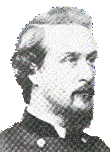 General Frank Wheaton, whose father-in-law was ranking general of the Confederacy Samuel Cooper, was born on May 8, 1833, at Providence, Rhode Island. He left Brown University at the age of seventeen in order to take a job with the Mexican-American Boundary Commission, where he worked for five years.
General Frank Wheaton, whose father-in-law was ranking general of the Confederacy Samuel Cooper, was born on May 8, 1833, at Providence, Rhode Island. He left Brown University at the age of seventeen in order to take a job with the Mexican-American Boundary Commission, where he worked for five years.
In 1855 he was commissioned directly into the 1st U.S. Cavalry (now 4th Cavalry) as a first lieutenant and saw considerable service on the Indian frontier. The outbreak of the Civil War found the family impossibly divided in sentiment: Wheaton's father-in-law, a native of Dutchess County, New York, was adjutant general of the army; his mother-in-law was a sister of Senator James Murray Mason of Virginia, who as a Confederate commissioner would become even more celebrated as the Mason of the Mason and Slidell affair which brought England and the United States to the brink of war.
Cooper sided with his wife's family; his daughter sided with her husband. The die being cast, Wheaton became lieutenant colonel of the 2nd Rhode Island Infantry, which fought at First Manassas and lost its colonel, Wheaton succeeded to command as of July 21, 1861.
In the campaign on the Virginia Peninsula, the 2nd Rhode Island was in Keyes's IV Corps; and at Williamsburg, Wheaton was commended for his conduct. On November 29, 1862, he was promoted to brigadier general of volunteers and assigned to a brigade
of the VI Corps with which he was connected until the war's end.
He was present as Fredericksburg in December, 1862, and again the following May when John Sedgwick carried Marye's Heights during the campaign of Chancellorsville. Wheaton remained in command of his brigade while U.S. Grant slugged his way through the Wilderness to the defenses of Petersburg, and then, in command of a division, Wheaton was hurried to Washington to repel the attack of Jubal Early's raiders on the capital.
During the ensuing operations in the Shenandoah under Philip Sheridan and after the return of the VI Corps to the Petersburg front, Wheaton earned the brevets of major general in the volunteer and regular services. He was mustered out of the volunteers in 1866, becoming lieutenant colonel of the 39th Infantry the same year.
In 1873 he commanded the expedition against the Modocs in the Lava Beds of northern California. (This expedition later resulted in the assassination of General Edward R. S. Canby, who had gone there to negotiate with them.)
Wheaton was appointed colonel of the 2nd Infantry in 1874; brigadier general, U. S. Army, in 1892; and major general in 1897. He died in Washington on June 18, 1903, and was buried in Arlington National Cemetery.
From Generals In Blue - Lives fo the Union Commanders, by Ezra J. Warner, 1992 p.553-554



